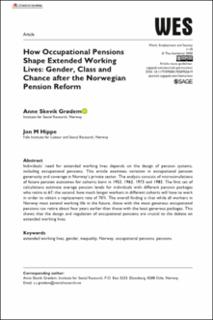How Occupational Pensions Shape Extended Working Lives: Gender, Class and Chance after the Norwegian Pension Reform
Peer reviewed, Journal article
Published version
Permanent lenke
https://hdl.handle.net/11250/2720482Utgivelsesdato
2020Metadata
Vis full innførselSamlinger
- Publikasjoner fra CRIStin [716]
- Tidsskriftpublikasjon [389]
Sammendrag
Individuals’ need for extended working lives depends on the design of pension systems, including occupational pensions. This article examines variation in occupational pension generosity and coverage in Norway’s private sector. The analysis consists of microsimulations of future pension outcomes for cohorts born in 1953, 1963, 1973 and 1983. The first set of calculations estimate average pension levels for individuals with different pension packages who retire at 67; the second, how much longer workers in different cohorts will have to work in order to obtain a replacement rate of 70%. The overall finding is that while all workers in Norway must extend working life in the future, those with the most generous occupational pensions can retire about four years earlier than those with the least generous packages. This shows that the design and regulation of occupational pensions are crucial to the debate on extended working lives.
